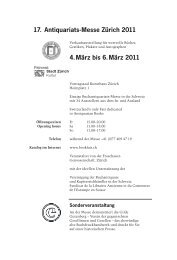- Antiquariats Messe Zürich Katalog
- Antiquariats Messe Zürich Katalog
- Antiquariats Messe Zürich Katalog
Sie wollen auch ein ePaper? Erhöhen Sie die Reichweite Ihrer Titel.
YUMPU macht aus Druck-PDFs automatisch weboptimierte ePaper, die Google liebt.
THE RINGS OF SATURN<br />
Huygens, Christian. SYSTEMA SATURNIUM, sive de causis mirandorum Saturni<br />
phaenonenon, et comite ejus planeta nuovo. The Hague: Adrian Vlack, 1659. [bound<br />
with:] DIVINI, EUSTACHIO [and HONORÉ FABRI]. BREVIS ANNOTATIO IN SY-<br />
STEMA SATURNIUM CHRISTIAN HUGENII . . . The Hague: Adrian Vlack, 1660.<br />
[bound with:] HUYGENS, CHRISTIAN. BREVIS ASSERTIO SYSTEMATIS SATUR-<br />
NII SUI … The Hague: Adrian Vlack, 1660. 4to. Three works in one volume: 1. (xii),<br />
84 pp, folding engraved plate, 11 fine engravings in the text, several text woodcuts;<br />
2. (ii), 23 pp, 1 engraved plate; 3. 20 pp, 4 text engravings, 1 text woodcut, with some<br />
plates folding where they extend beyond the margin. Full calf, period style. Occasional<br />
neat marginalia, owner’s stamp, a few minor flaws, but a fine, fresh copy. 40’000.–<br />
FIRST EDITIONS of Huygens’s works. In 1655 Dutch scientist and instrumentmaker<br />
Christian Huygens turned his new telescope to Saturn, which to early observers<br />
had at times unexplained protrusions extending from either side. He constructed<br />
a more powerful telescope to solve the problem, and in 1656 he was able to resolve the<br />
handles into a ring encircling the planet. In 1659 Huygens published his findings as<br />
Systema Saturnium. In the preface he declares that Saturn, its ring, and its satellite<br />
(Titan, which he discovered in the course of his observations) form a system supporting<br />
the Copernican system of a heliocentric universe. He describes a thick, solid<br />
ring at the planet’s equator and explains the perplexing changing appearance of<br />
Saturn by the fact that the ring is tilted 20 degrees to the plane of Saturn’s<br />
orbit, in constant orientation as the planet orbits the Sun but changing with respect<br />
to observers on Earth. The book is elegantly printed with fine engravings.<br />
At first, Systema Saturnium was not well-received. Most astronomers rejected its<br />
theories or held strong reservations. In Rome, telescope maker Eustachio Divini<br />
issued Brevis Annotatio (Brief Comment) a pamphlet describing the ring theory as<br />
fantastic, attacking his telescopes and observations, and rejecting his Copernican<br />
arguments. Huygens immediately had that tract reprinted (it is the second item in<br />
this bound volume) and replied with his Brevis Assertio (Brief Defense, the third<br />
work in the volume), which convinced Hevelius to accept the theory. Within a few<br />
years the theory was widely accepted, and even Divini accepted it when he constructed<br />
an improved telescope.<br />
This is a fine association copy with the stamp of F. X. Zach (1754-1832) on the titlepage.<br />
Zach was director of the Gotha Observatory and editor of the first astronomical<br />
journal.<br />
Dibner, Heralds of Science 9.<br />
55<br />
Stand 30






